Cataloger's Reference Shelf
CONSER Cataloging Manual
22.4. Description
The description of serials was quite different before the days of online databases and "universal" records. Libraries described what they had and in what form they had it. Although most used Library of Congress cards, the cards were often modified to reflect the actual holdings of the library.
The rules for description of serials changed very little throughout the ALA codes and even into AACR. For both latest entry (ALA) and successive entry (AACR) records the description was based on the latest issue and notes referred to earlier issues. (This is the opposite of AACR2 where description is based on the earliest issue.) One effect of the latest entry policy prescribed by the ALA rules was that the records covered longer time spans, thus allowing for more changes that were expressed in lengthy, complicated notes. Despite efforts to keep the body of the entry simple, the many notes for changes of title, imprint, issuing body, and so forth tended to give the records a "cluttered" appearance.
Three developments occurred during the early 1970’s that had a great impact on serial cataloging: the introduction of online cataloging systems and the MARC record, the development of the International Serials Data System (ISDS) (FN 6), and the beginnings of the CONSER (Conservation of Serials) Project (FN 7).
The Library of Congress began creating machine-readable records for serials in the Roman alphabet in February 1973 and also began the distribution of these records on tape. Some of the changes resulting from the adoption of MARC were that notes that formerly could be combined now had to be separated according to their appropriate tags, and that supplements that would formerly have been "dashed-on" to the entry had to be input as separate records. Perhaps the greatest innovation was the concept of the "linking field," which combined the note for a related title with a machine link to the record for that title.
At about the same time, LC decided to minimize differences in its cataloging records with the records created for the ISDS database and adopted the concept of the generic title (described below) and the use of the key title and ISSN in linking fields. In 1976, LC also began printing the key title and ISSN on its cards.
The CONSER Project, which began in 1973, and the development of a cooperative database, prompted the Library of Congress and other libraries to create records that would contain universal, rather than institution-specific information. It was agreed that information given would reflect the entire serial, so that input from various libraries with different holdings could be accommodated. In 1977, LC announced that the "holdings" area on its printed cards would reflect information known about the serial’s existence rather than LC’s holdings.
22.4.1. Basis for the description
As mentioned above, description was based on the latest issue; however, no "description based on" note was given. Libraries frequently waited for receipt of a volume title page upon which to base the description. (See also CCM 22.4.12.)
22.4.2. Capitalization, punctuation, and bracketing
In earlier records, less capitalization was used, perhaps paying heed to Cutter’s advice that "capitals are to be avoided, because in the short sentences of a catalog they confuse, rather than help the eye (FN 8)." Perhaps the most obvious difference is that only the first word of the publisher statement was capitalized in ALA entries created according to the 1908 and 1949 rules.
Punctuation was less standardized, and generally followed common grammatical practice. Subtitles were preceded by a colon or a semicolon, and part titles were generally preceded by a semicolon or period. Elements of the imprint were separated by commas. ISBD punctuation was not adopted for serials until AACR2; however, pre-AACR2 records may be found incorrectly containing ISBD punctuation with code "i" in the descriptive cataloging code element of the fixed field. This was the practice adopted for monographs when the revised chapter 6 for monographs was issued.
Bracketing in earlier records is limited, for the most part, to information added to the description that did not appear on the piece. Under the 1908 rules, brackets were used only for words added to the title or imprint. ALA 1949 and AACR call for all additions to be given in brackets. There is no concept of "prescribed sources" in any of the rules.
22.4.3. Transcription of the title
Under the ALA rules, titles were "truncated" to exclude the frequency and the name of the issuing body (unless given in a significantly different form) when entry was under the corporate body.
Annual
report of the Department of Public Works was recorded as:
Report.
Monthly
financial statement was recorded as:
Financial statement.
If the title began with the initials of a person’s name, the initials were dropped.
J.W. Pepper
piano music magazine was recorded as:
... Pepper piano music magazine.
With the adoption of AACR, truncation of titles ceased.
Short titles were preferred by all of the codes so as to allow for minor variations in title that would not constitute a title change. This practice was particularly useful for conference publications which were simply given the title "Proceedings" or "Transactions," conveniently ignoring the many subtle changes in the full titles given on the pieces.
American Nuclear Society.
Transactions.
Statements that introduced the designation, such as "for the year ending" or "during fiscal year" were rarely given as part of the title and were omitted entirely from the description although the information conveyed by such statements was often given in the notes area.
Report covers the fiscal year ending July 31.
In 1975, LC adopted the concept of the "generic title" from the series area of the Revised Chapter 6 of AACR for monographs. The generic title, which was also used by ISDS, was a title consisting solely of words that "indicated the kind and/or periodicity of a publication." The generic title was used in both the 245 and 4XX fields and consisted of the title followed by a space-hyphen-space ( - ) and the author statement or name of the issuing body as it appeared on the piece.
Annual conference proceedings - [body]
Annual report - [body]
Membership directory - [body]
Research paper - [body]
Titles containing words that indicated subject content or titles containing other words that did not fit the definition were not treated as generic titles. Also not considered to be generic were titles that contained the initialism or acronym of the body. (CSB 112, winter 1975).
Titles that appeared only on a limited number of issues were not a problem for latest entry records as they could be included in a note. When successive entry was adopted, the practice of noting titles of short duration was continued. CONSER members, however, found this practice hard to apply in a cooperative database. Disagreements on what was a "short duration" and the fact that this could be judged only in hindsight finally led the Library of Congress (and CONSER) in 1977 to cease to apply the rule. From that point on all title changes were given separate entries, except those of a "very minor character," e.g., changes near the end of a long title. (CSB 120, winter 1977).
e. Initialism plus full form of title
A new rule interpretation for titles that included initialisms and full forms was introduced in 1975. When the title consisted of a set of initials or an acronym and the expanded form, both were given as the title proper, separated by a comma. The initialism was given first, followed by the full form, regardless of the appearance on the piece. (CSB 112, winter 1975).
BPR, American book publishing record
JOLA, Journal of library automation
f. Field 247 and successive entry records
The use of field 247 (former title or title variations) was allowed in an AACR successive entry record when on one piece the title, as cataloged, consisted of a generic title and the issuing body separated by a space-hyphen-space, and on another piece the title consisted of the same generic term grammatically linked to the issuing body, or vice versa. The earlier title, in these cases, was tagged 247 and a 500 "Title varies slightly" note was given. The successive/latest entry indicator in the fixed field was set to "0".
245 00 $a Bulletin - Council on Library Resources.
247 01 $a Bulletin of the Council on Library Resources
500 ## $a Title varies slightly.
S/L = 0
The importance of subtitles waxed and waned. Both ALA and AACR rules called for their omission unless considered necessary for the identification of the title. Many latest entry records are found, however, noting changes that occurred only in the subtitle. In many AACR records the subtitle was omitted but the information was included in a quoted note.
On many older entries the mark of omission was given wherever information was omitted--at the beginning, middle, or end of a title. Under AACR, numbers and dates were omitted without using the mark of omission.
... Situazione del tesoro ... presentata dal ministro delle finanze
... (ALA)
In early online records, parallel titles were omitted from the title in 245 and were given only in the field 246. The print program was supposed to transfer this information to its appropriate place following the title proper; however, this was never implemented.
22.4.4. Statement of authorship
The statement of authorship or editorship under ALA rules sometimes appeared in the body of the entry and sometimes in notes. Under AACR, the statement of authorship was never given in the body of the entry unless it was an integral part of the title.
Rather than recording the numeric/ chronological designation of the first/last issue as it does in AACR2, the holdings area recorded the actual holdings of the library. If LC had the first volume, it was recorded. If LC did not have the first volume, the area was left blank. As a result, many LC cards have no statement of holdings. The practice at many libraries was to pencil in holdings in this area as bound volumes were received. If LC did not have the first volume but information concerning it was known, this information was given in a note.
A publication did not have to have a designation to be considered a serial by LC. If the publication was determined to be a serial, or LC wished to catalog it as a serial, a designation could be taken from the preface or the publication date could be used if no other designation appeared on the piece. As a result, many publications were cataloged as serials that today would be cataloged as monographs. Reference works that were issued in frequently revised editions were often treated in this manner.
When recording designations, certain conventions were applied. Unnecessary elements of the date were not given, as determined by the frequency of the serial. Closing dates usually consisted of only the last two digits of the year (e.g., 1908-22). If the serial was a monthly, only the month and year were given; if it was an annual, only the year was given. Conventions of punctuation were also applied. Fiscal years were separated by a slash ( / ) and two calendar years were separated by a hyphen ( - ). The beginning and ending volume designations preceded the beginning and ending dates. If the serial began with v. 1, no. 1, "no. 1" was omitted; if a monthly began in January, the year was given and "Jan." was omitted. When there were two systems of numbering the whole numbers were given in parentheses following the volume numbers.
V. 1-12, no.2; 1893-Feb. 1904
1945/46-
año 1- (no. 1- ); 31 enero 1940-
Because description was based on the latest issue, the place and publisher given were always the latest. If the place and/or publisher changed, the latest was given in the imprint. Earlier ones were given in notes. However, if the change was considered unimportant, "etc." was given in the imprint following the place or publisher. When several changes occurred, "etc., etc." might be given. If the publisher was the same as the main entry, the publisher statement was omitted. If the place and/or publisher was unknown, the abbreviation "n.p." (no place/publisher) was used. For conferences or other serials issued in different locations, the abbreviation "v.p." (various places) was used for the place. LC announced in winter 1975 (CSB 112) that in addition to rule 164, the imprint for serials henceforth would be based on rules in revised chapter 6. One of the resulting changes was the use of "s.l." ( sine loco) and "s.n." ( sine nomine) in place of the "n.p." abbreviation. Another was that the publisher could no longer be omitted.
The date of publication was given in earlier ALA records, sometimes in partial form, such as "18" or "19". The date was usually omitted under AACR, but was given when there was no chronological designation on the piece.
The collation described the number of physical volumes held by the library in terms of volumes ("v.") or numbers ("no."). If a library had several bibliographic volumes bound together, the extent was expressed as "2 v. in 1" or "5 no. in 2 v." If a serial was complete in one volume, the number of pages was given. The abbreviation "illus." was used for illustrations. Illustration statements were often extensive and included terms that are not considered to be illustrations under AACR2, such as "diagrs." tables," and "plates." Size could be given in fractions. On early ALA records the source of title was given preceding the number of volumes when the source was not the title page.
22 no. in 18 v. 22-24 cm.
3 v. illus., ports. 19½ cm.
cover-title, 128 p. incl. 16 port. 24 cm.
When the series was entered under the same corporate body that was used as the main entry, the body was expressed in the series statement as "Its [title of series]". Likewise, if the series and serial were entered under the same personal name, the series was given as "His ... " or "Her ... ". In these cases, an explicit series tracing was given that provided the complete form of the name.
main entry:
Zambia. Statistics Office.
series statement:
Its Official report
series tracing:
Zambia. Statistics Office. Official report.
In 1974, the rule allowing this form of abbreviation was abolished (CSB 108, April 1974). If the name appeared as part of the title on the piece, it was included in the series statement on the record.
When there was more than one series, the second was given as the first note. This was also the practice when not all of the issues of the serial were issued in the series (see Figure 22.14.).
The concept of generic terms was also applied to series and the series statement was recorded as [title] - [author]. Following its policy for superimposition (see CCM 22.5.1.), LC announced that it would apply the new rules only to series that were not yet established. If an analytic was cataloged after the adoption of the rule, the series statement would be constructed as a generic title, but the series tracing would remain in its old form.
series entry:
Geological Society of America. Memoir.
series statement on analytic:
(Memoir - Geological Society of America)
series tracing on analytic:
Series: Geological Society of America. Memoir.
The same types of notes were given in older records as are given in AACR2; however, because description was based on the latest issue, the notes covered earlier rather than later information. Many notes were given that have not changed under present rules. When possible, notes about various aspects of the serial were combined into one statement. The notes mentioned below, for the most part, vary in some way from present practice.
The frequency was given unless it was already expressed in the title. When there were numerous changes in frequency, generally more than three, the frequency was omitted and the phrase "Frequency varies" was given.
When the Library’s holdings did not reflect the entire run of the serial the beginning or ending information was supplied in a note. A note was also preferred when the information was uncertain.
Ceased publication with v. 4, no. 4 (Aug. 1935?) Cf. Union list of serials.
"Published ... since 1909."
"Established in 1904."
Began publication with Dec. 1916 issue under title: Fibre containers. Cf Union list of serials.
c. Notes relating to issuing body/corporate author
Under the ALA rules, the latest form of the name of a corporate body was given in headings. If the serial was issued by the body under its earlier name, a note was given.
Issued by the society under an earlier name: Royal Colonial Institute.
The same principle was applied when the issuing body changed (i.e., two different bodies).
The editors of a serial were often given in notes on ALA records, sometimes in great detail. Editors that were noted were given added entries. This practice was less common under AACR.
d. Notes relating to preceding and succeeding titles
Under ALA rules, a serial title change that was accompanied by a change in numbering required a new entry. The linking note used the terms "supersedes" and "superseded by." (In MARC records the link was coded with a second indicator value of "2"--supersedes, or "3"--supersedes in part.)
Supersedes the Tropical veterinary bulletin.
Began publication in May 1935, superseding the federations' Bulletin.
Under AACR, changes in title and/or main entry required a new "successive" entry. If the numbering remained continuous or the serial had no numbering, the terms "continued by" and "continues" were used. If the numbering changed, the terms "supersedes" and "superseded by" were applied.
After the MARC format was adopted, the form of entry was usually the cataloging entry. Due to the complications of superimposition, LC often found it necessary to use the 580 linking complexities note.
LC announced in Spring 1976 (CSB 117) that notes citing other serials would henceforth give the key title and ISSN, when readily available. If the key title was not available, the serial was cited by cataloging entry.
780 02 $t Annals of mathematical statistics $x ISSN 0003-4851
780 00 $t Research paper- Land Tenure Center, University of Wisconsin-Madison $x 0090-7170
e. Notes relating to key title
In spring 1976, LC also announced that the key title and ISSN would be printed as a note on catalog cards.
Minor title variations were allowed under all of the earlier rules and many records will be found with a "Title varies slightly" note. Major changes were given in notes, generally preceded by "Title varies" or "Issues for [dates] have title:" (ALA rules only).
Title:
The New Zealand port and telegraph officers' advocate.
Note:
Title varies:1891, New Zealand post and telegraph gazette.–1892-1902, The Katipo; a journal of events in connection with and circulated only in the New Zealand post office and telegraph service (subtitle varies slightly)–1903-Apr. 1906, The New Zealand post and telegraph officers' advocate.
g. Notes relating to titles appearing on various parts of the serial
LC announced that standard terms would henceforth be used to note different forms of the title. These terms matched the display constants (then called print constants) defined for the second indicator value of the 246 field, e.g., cover title, spine title, etc. (CSB 112, winter 75).
This note was given when the cataloger was not sure whether the issue designated as the last issue in the holdings was in fact the last issue.
To save space on cards and other printed products, notes were frequently combined. With the introduction of MARC records, however, different types of notes could no longer be combined because the tagging differed (CSB 112, winter 75).
Combined:
Suspended 1838-39; ceased with vol. for 1848.
Separate:
362 1# $a Ceased with vol. for 1848.
515 ## $a Suspended 1838-39.
Supplements that were important enough to be specifically mentioned, but that were not cataloged on a separate record, were given as "dash" entries following the notes relating to the main work. The "dashed-on" supplement could be a serial or a monograph. One dash represented the repetition of the author or title as given in the main entry. If entry was under author and the title of the serial also formed part of the title of the supplement, two dashes were given, one for the author and the second to represent the title.
The Cornhill magazine. v. 1-
(no. [1]- ); Jan. 1860-
London, J. Murray [etc.]
v. illus. (part col.) ports., maps 22-24 cm.
[Notes]
----- Supplement. no. 1-
London, J. Murray [1951-
v. 22 cm.
Verein Deitscher Ingenieure, Berlin.
Zeitschrift. Bd. 1- 1857-
Berlin.
v. illus., maps, diagrs. 30 cm.
--- ---- Beihefte Verfahrenstechnik, Schriftenfolge fur Chemie-Ingenieure, Apparatebayer und verwandte Berufe.
"Dashed-on" entries could not be accommodated in the MARC format and LC announced that supplements formerly represented by such notes would henceforth be cataloged separately (CEB 114, summer 75).
As with current practice, indexes to single volumes were not recorded; indexes to multiple volumes were cataloged with the serial they indexed. Information was given in tabular form and specific types of indexes were given separately.
Indexes:
Author index.
Vols. 1-6, 1915-21, with v. 6.
Subject index.
Vols. 1-6, 1915-21, with v. 6.
Because the description was based on the latest issue and there was no place in the cataloging record to indicate what that issue was, field 936 was defined for CONSER use to indicate, among other things, the issue upon which the description was based.
Field 936 actually served several purposes. If a CONSER participant updated a record that did not contain a 936 field, "Unknown" was input followed by the latest issue consulted by the CONSER participant. If a record was updated without an issue in hand, "INC" (issue not consulted) was added. When cataloging from a surrogate, rather than the issue, the term "surrogate" was added after the designation for the issue. The term "surrogate" was also used to express the fact that a CONSER participant had sent a surrogate to LC for authentication.
936 ## $a Vol. 36, no. 5, April 1977
936 ## $a Unknown $a 1978
936 ## $a INC
936 ## $a 1979 (surrogate)
Description (ALA) -- ALA (early records)
The records below were cataloged during the early 1900s, probably based on the rules of 1908. Notice the presence of titles that are probably truncated, lack of a designation (in the first example), incomplete information in the publishing area, and latest entry data for title and heading (in the second example).
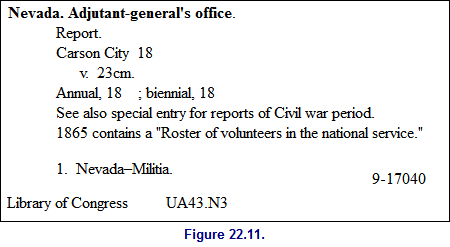
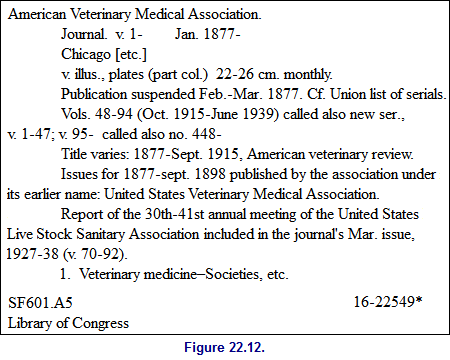
Description (ALA) -- ALA (later records)
The records below were created during the middle part of the century, probably based on the rules of 1949. Notice the capitalization in the heading in Fig. 22.14.
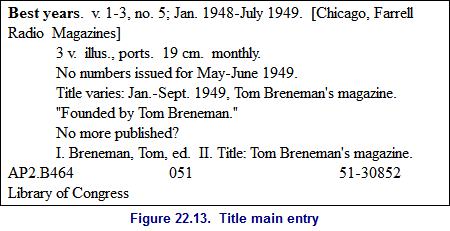
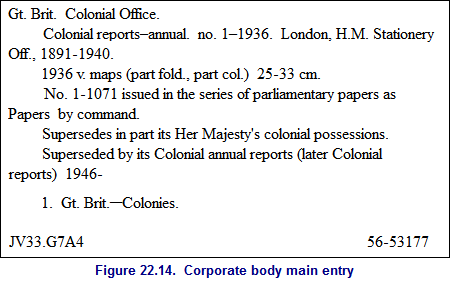
Description (AACR)
The records below illustrate both card and online formatted records created according to AACR. Note the use of [s.n.] in the first record and the treatment of the initialism in the second. The ISSN and key title are also present in both records.
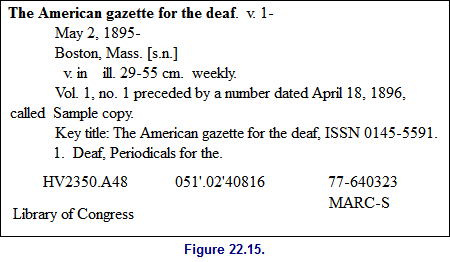
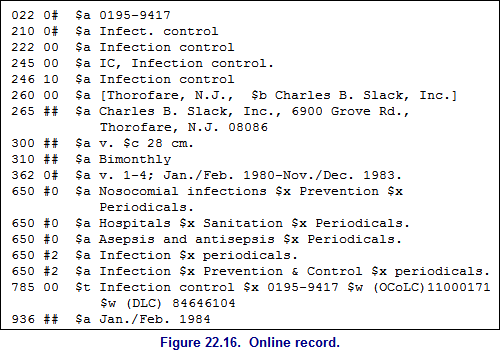
See also: